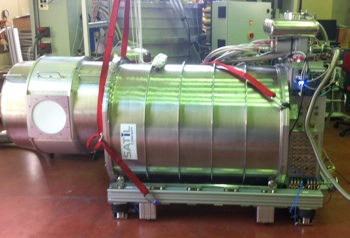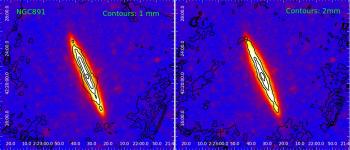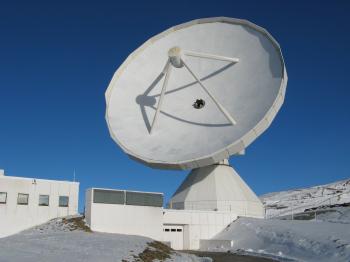Suzanne Madden, from the Department of Astrophysics at CEA, is the principal investigator of IMEGIN (Interpreting the Millimetre EMission of Galaxies), one of 5 Guaranteed Time Large programs proposed by the NIKA2 collaboration. About 200 observing hours have been awarded on the 30m IRAM telescope.
The millimeter part of the spectrum is one of the least explored parts of a galaxy's spectral energy distribution, yet it contains emission from three fundamentally important physical processes. These processes are thermal emission from dust, free-free emission from ionized gas and synchrotron emission from relativistic charged particles moving in the galactic magnetic field.
The key science themes that will be tackled by this large program are:
1) Disentangling spatially resolved galaxy spectral energy distributions (SEDs) from dust contribution, free-free and synchrotron emission. Creation of parameter maps (mass, temperature...).
2) Evolution of the dust-to-gas mass ratio within galaxies. Links with the chemical evolution of galaxies and with the reservoirs for dust production.
3) Microscopic properties of dust: constraints on millimetric opacity.
4) Study the sub-millimeter excess in galaxies, whose origin is still unknown.
The perceived wisdom is that the 1.2mm emission is primarily from thermal dust emission, while that at 2mm will be contaminated by free-free emission. Longer than 2mm we expect the emission to be dominated by the synchrotron emission from relativistic electrons.
The NIKA2 data will provide additional data points for input into the comprehensive spectral energy distribution models and will allow us to investigate, for instance, changes in the emissivity index. Of particular interest is the possibility of excess long wavelength emission over and above that predicted by the Herschel data. This may indicate a significant very cold dust component (T<10K) and/or non-thermal grain emission (e.g., magnetized grains or rotating grains).
The collaboration gathers researchers from 14 institutes, including 7 in France, with major contributions from the NUAGES group at CEA LFEMI.
List of contributing institutes:
- France: CEA, IAP, IRAM, LAM, IRAP, IAS, IPAG
- Athens observatory, University of Ghent, IPM/Iran, STScI, Calar Alto Obs, Nat. Univ of Ireland, Univ. Cardiff.

NIKA2 is a new millimeter array on the 30m IRAM telescope, observing at 1.2mm and 2mm (wavelengths beyond those accessible with the Herschel Space Telescope) with a beam size (spatial resolution) of 11"and 17" respectively and a field of view of 6.5'.
The IMEGIN sample contains galaxies of varying morphological type that reside in distinctive environments. The sample also contains some of the largest angular sized objects in the sky and so will lead to spectacular publicity material.
About 40 galaxies were selected, with the following properties:
1) Full MIR to submm continuum wavelength coverage to constrain accurate dust SED models.
2) Radio wavelength observations to constrain the non-dust components.
3) Molecular (CO) and atomic (HI) gas measurements to obtain the gas-to-dust ratio.
4) Distances <30Mpc to ensure adequate linear resolution scales to fulfill the science aims (30Mpc equates to 1.5kpc and 2.5kpc resolution using the NIKA2 1.2mm and 2mm bands respectively).
Scientific contact: Suzanne Madden (suzanne.madden@cea.fr).



